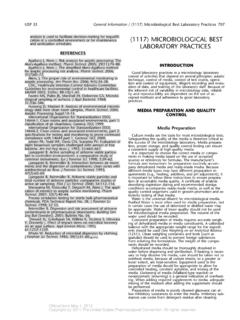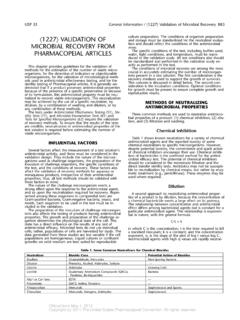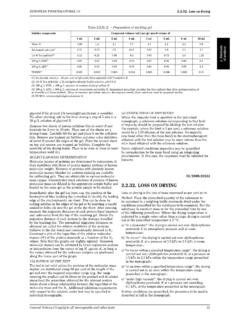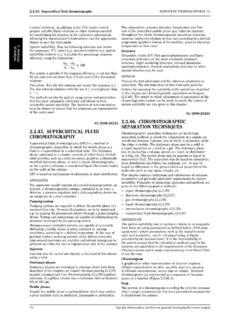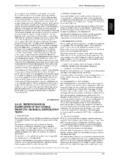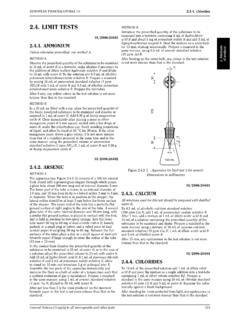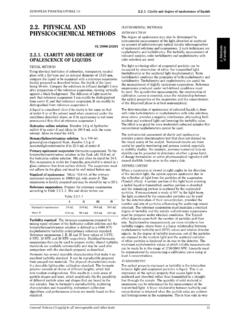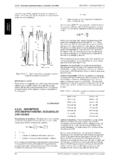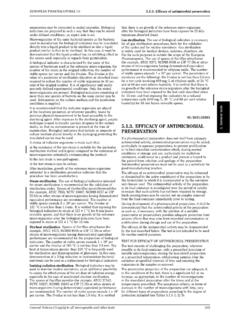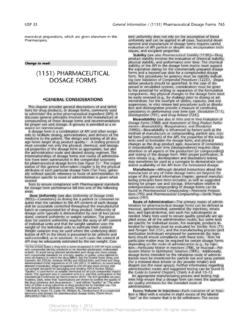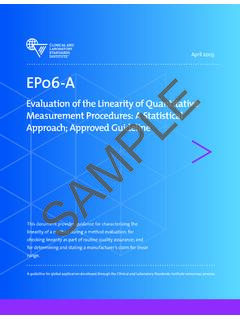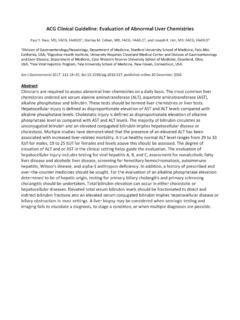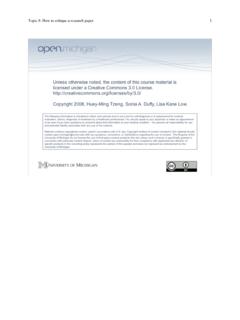Transcription of <912> ROTATIONAL RHEOMETER METHODS - DrugFuture
1 Second supplement to USP 35 NF 30 Physical Tests / 912 ROTATIONAL RHEOMETER METHODS 5651 Calibration and Calculation of kinematic and Newtonianviscosities of sample fluid: Proceed as directed in (USP35)Add the following:.n 912 ROTATIONAL RHEOMETERMETHODSThe principle of the method is to measure the force (torque)acting on a rotor when it rotates at a constant angular veloc-ity ( ROTATIONAL speed) in a liquid. ROTATIONAL rheometers/vis-cometers are used for measuring the viscosity of Newtonianfluids, , a fluid having a viscosity that is independent ofthe shearing stress or rate of shear, or the apparent viscosityof non-Newtonian fluids, which may exhibit different rheo-logical behavior, depending on shear rate, shear stress, andtemperature. The following procedures are used to determinethe viscosity of Newtonian fluids or the apparent viscosity ofnon-Newtonian fluids.
2 The calculated viscosity of Newtonianfluids should be the same (within experimental error), regard-Figure 2. Disc-shaped spindlesless of the rate of shear (or ROTATIONAL speed). Given the de-pendence of viscosity on temperature, the temperature of theProcedure: Under these test conditions the shear rate variessubstance being measured should be controlled to withinbetween the outer surface of the spindle and the inner sur- , unless otherwise specified in the individual mono-face of the beaker or cup containing the test substance. As agraph. Unless otherwise directed in the individual mono-result, the following additional information must be de-graph, use Method along with the measured viscosity: METHOD I. SPINDLE RHEOMETERS (RELATIVE RHEOMETERS and geometry of spindleDLE VISCOMETERS) velocity of the spindleApparatus: In the spindle RHEOMETER , the apparent dimensions of the test substance containeris determined by rotating a cylinder- or disc-shaped spindle, of the test substanceas shown in Figures 1 and 2, respectively, immersed in of instrument accessories, such as a spindle guardlarge volume of preparation of the test specimen, including its tempera-ture equilibration, is specified in each individual mono-graph.
3 Follow the instrument manufacturer s recommenda-tions regarding sample loading, spindle selection, andrheometer : Select at least two calibration standards whoseviscosities differ by an appropriate value within the viscosityrange of the test substance under measurement for a partic-ular RHEOMETER configuration. Measure the apparent viscosi-ties of each standard, as described above, at multiple rota-tional RHEOMETER is deemed to be calibrated if the measuredapparent viscosities are within 5% of the stated , calibration, operation, and cleaning of rheometersshould be performed according to the recommendations ofthe instrument manufacturer. METHOD II. CONCENTRIC CYLINDER RHEOMETERSA pparatus: In the concentric cylinder RHEOMETER , the appar-ent viscosity is determined by placing the liquid in the gapbetween the inner cylinder and the outer cylinder.
4 Both con-trolled-stress and controlled-rate ROTATIONAL rheometers areavailable commercially in configurations with absolute ge-ometries ( , very small annular gaps between concentriccylinders) that can provide consistent meaningful rheologicaldata for non-Newtonian fluids. Controlled-stress rheometersprovide controlled-stress input and measurement of the re-sulting shear rate. Controlled-rate rheometers provide con-trolled-shear rate input and determination of the resultantshear stress, measured as torque, on the rotor axis. Concen-Figure 1. Cylinder-shaped spindlesOfficial from December 1, 2012 Copyright (c) 2012 The United States Pharmacopeial Convention. All rights from by nEwp0rt1 on Tue Jun 05 03:52:14 EDT 20125652 912 ROTATIONAL RHEOMETER METHODS / Physical TestsSecond supplement to USP 35 NF 30tric cylinder ROTATIONAL rheometers are sometimes referred toas cup-and-bob rheometers.
5 These rheometers involve anadditional design consideration depending on whether theouter cylinder (the cup) or the inner cylinder (the bob) ro-tates. Rotating-cup rheometers are called Couette systems,while rotating-bob rheometers are called Searle systems, asshown in Figures 3 and 4, 4. Searle concentric cylinder system for rotationalrheometryProcedure: Place a sufficient quantity of a test solution orfluid in the RHEOMETER , and allow the sample to reach ther-mal equilibrium, as indicated in the individual the RHEOMETER following the procedure recom-mended by the instrument manufacturer. For non-Newtonian systems, the monograph indicates the type ofFigure 3. Couette concentric cylinder system for rotationalrheometer that should be used and the shear rate(s) atrheometryOfficial from December 1, 2012 Copyright (c) 2012 The United States Pharmacopeial Convention.
6 All rights from by nEwp0rt1 on Tue Jun 05 03:52:14 EDT 2012 Second supplement to USP 35 NF 30 Physical Tests / 912 ROTATIONAL RHEOMETER METHODS 5653which the measurements should be made. [NOTE If there isCalibration: ROTATIONAL rheometers require calibration withevidence of time-dependent ( , thixotropic or rheopectic)rheological standards appropriate for the shear rate or shearrheological behavior, this should be noted as well.] As notedstress ranges and the nature of the fluid or material underabove, apparent viscosity should be determined preferablyevaluation. To determine or confirm the apparatus constant,over a range of shear rates appropriate to the material underperform the necessary tests beforehand, using fluids oftest. The procedure employed to measure the apparent vis-known viscosities of appropriate viscosity standards at thecosity of the liquid is repeated, using a series of differentrequired speeds or torques.
7 From a series of such viscosity METHOD III. CONE-AND-PLATE RHEOMETERS measurements, the relationship between the shear rate andApparatus: In the cone-and-plate RHEOMETER , the liquid isthe shear stress of a non-Newtonian liquid that is, the flowintroduced into the gap between a flat disc or plate and acharacteristics of the non-Newtonian liquid can becone forming a defined angle. Viscosity measurement performed by rotating the cone or the plate, as shown inCalculation of shear rate, shear stress, and viscosity: ForFigures 5 and 6, respectively. [NOTE Because the volume ofnon-Newtonian liquids, it is essential to specify the shearsample is small, even a small absolute loss of solvents canstress, s, or the shear rate , at which the viscosity is meas-cause a large percentage change in viscosity. Such a loss isured.]
8 Under narrow gap conditions (conditions satisfied inparticularly relevant for volatile solvents but could beabsolute rheometers), the shear rate in s-1, and the shearsignificant even for nonvolatile solvents such as water.]stress s, in Pa (N m-2 or kg m-1 s-2), are calculated usingEquations (1) and (2) below:RO= radius of the outer cylinder (m)RI= radius of the inner cylinder (m)w= angular velocity (radians/s)M= torque acting on the cylinder surface (N m)h= height of immersion of the inner cylinder in theliquid medium (m)Generally, the angular velocity can be calculated usingEquation (3):n= ROTATIONAL speed, in revolutions/min (rpm)For laminar flow, the viscosity h (or apparent viscosity hApp),in Pa s , is given by the following equation:[NOTE 1 Pa s = 1000 mPa s.]k= the constant of the apparatus (radians/m3)Figure 5.
9 Cone-and-plate ROTATIONAL RHEOMETER with rotatingconeOfficial from December 1, 2012 Copyright (c) 2012 The United States Pharmacopeial Convention. All rights from by nEwp0rt1 on Tue Jun 05 03:52:14 EDT 20125654 912 ROTATIONAL RHEOMETER METHODS / Physical TestsSecond supplement to USP 35 NF 30a= angle between the flat plate and the cone(radians)R= radius of the cone (m)w= angular velocity (radians/s)M= torque acting on the flat plate or cone surfaceFigure 6. Cone-and-plate ROTATIONAL RHEOMETER with rotating(N m)plateFor laminar flow, the viscosity h (or apparent viscosity hApp),in Pa s, is given by the following equation:Procedure: Proceed as directed for Method II. ConcentricCylinder of shear rate, shear stress, and viscosity: Theshear rate in s-1, and the shear stress s, in Pa, arecalculated by Equations (5) and (6).
10 K= constant of the apparatus (radians/m3)Calibration: Proceed as directed for Calibration in Method Cylinder (USP35)Official from December 1, 2012 Copyright (c) 2012 The United States Pharmacopeial Convention. All rights from by nEwp0rt1 on Tue Jun 05 03:52:14 EDT 2012 Second supplement to USP 35 NF 30 Physical Tests / 913 Rolling Ball Viscometer Method5655each single measured rolling time, the resulting viscosity canAdd the following:be expressed as dynamic viscosity (mPa s) as well as kine-matic viscosity (mm2/s) for a sample of known :Select a measuring system [tube (or capillary)n 913 ROLLING BALLand ball combination] within the anticipated range of vis-cosity of the sample liquid. As necessary, heat the clean andVISCOMETER METHODdry tube and ball of the viscometer to the temperaturespecified in the individual monograph, and control the tem-perature to , unless otherwise specified in the individ-The following procedure is used to determine the viscosityual monograph.
